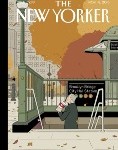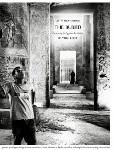Peter Hessler (China 1996-98) Letter from Abydos in New Yorker
The Buried
Excavating the Egyptian Revolution.
by Peter Hessler The New Yorker, November 18, 2013
 From Cairo, it’s only about three hundred miles to Abydos, in Upper Egypt, but the distance feels much greater. This region has been a world apart ever since Pharaonic times. The ancient Egyptians separated their land into Upper and Lower, a division that confuses moderns who orient themselves by the compass rather than by the Nile. Upper Egypt lies to the south, where the river has carved a deep gorge into the North African plateau. At Abydos, the gorge is about fifteen miles wide, flanked on both sides by high cliffs that are the color of sand. There’s no rain to speak of, and the surrounding desert is absolute: from the air, the narrow corridor of green along the Nile appears hopelessly isolated. Head due west and the next river you cross is in South Florida. But more than thirty million people live in this arid place, representing about forty per cent of the country’s population. An even greater miracle is how long they’ve been here. This was the cradle of Egyptian civilization, and the earliest known hieroglyphics, dating to around 3200 B.C., were discovered inscribed into relics that had been buried near those Abydos cliffs.
From Cairo, it’s only about three hundred miles to Abydos, in Upper Egypt, but the distance feels much greater. This region has been a world apart ever since Pharaonic times. The ancient Egyptians separated their land into Upper and Lower, a division that confuses moderns who orient themselves by the compass rather than by the Nile. Upper Egypt lies to the south, where the river has carved a deep gorge into the North African plateau. At Abydos, the gorge is about fifteen miles wide, flanked on both sides by high cliffs that are the color of sand. There’s no rain to speak of, and the surrounding desert is absolute: from the air, the narrow corridor of green along the Nile appears hopelessly isolated. Head due west and the next river you cross is in South Florida. But more than thirty million people live in this arid place, representing about forty per cent of the country’s population. An even greater miracle is how long they’ve been here. This was the cradle of Egyptian civilization, and the earliest known hieroglyphics, dating to around 3200 B.C., were discovered inscribed into relics that had been buried near those Abydos cliffs.
Abydos is the ancient name for a cluster of villages at the western edge of the gorge. During much of Pharaonic times, this was the most sacred spot in the country, and today there’s still an elevated stretch of desert next to town that’s largely protected from any farming or development. Locals call it al-Madfuna: the Buried. For more than five millennia, this ground was used as a cemetery, and it’s been the focus of intensive archeological work since the mid-eighteen-hundreds. It’s also attracted looters during times of political instability. In February of 2011, as the revolution gathered strength in Tahrir Square, all across the country the police disappeared, and in the Buried teams of looters opened more than two hundred pits. It wasn’t until the end of March, after President Hosni Mubarak resigned and the national situation had stabilized somewhat, that village police resumed patrols of the site.
Nearly two years later, in January of 2013, a team from the Institute of Fine Arts at New York  University arrived to undertake an archeology of the revolution. They followed the thieves’ tracks across the Buried, seeing where they had gone, and how they had dug, and what they had destroyed. The archeologists excavated every major looting pit, measuring and mapping with satellite imagery. The team included four excavators, three conservators, two surveyors, two architectural specialists, a photographer, an artist, and two inspectors from the Ministry of Antiquities. They hired more than fifty local laborers. Some men specialized in digging out sand, and there were boys who carried it away in buckets, while other boys poured the sand through wire screens in search of broken artifacts. Six teen-agers were hired specifically to handle a custom-built fifteen-foot-tall stepladder that allowed the photographer to shoot the pits from above, as if they were crime scenes. Uncovered relics tended to be forensic rather than Pharaonic. Conversations could be as crisp as Chandler. . .
University arrived to undertake an archeology of the revolution. They followed the thieves’ tracks across the Buried, seeing where they had gone, and how they had dug, and what they had destroyed. The archeologists excavated every major looting pit, measuring and mapping with satellite imagery. The team included four excavators, three conservators, two surveyors, two architectural specialists, a photographer, an artist, and two inspectors from the Ministry of Antiquities. They hired more than fifty local laborers. Some men specialized in digging out sand, and there were boys who carried it away in buckets, while other boys poured the sand through wire screens in search of broken artifacts. Six teen-agers were hired specifically to handle a custom-built fifteen-foot-tall stepladder that allowed the photographer to shoot the pits from above, as if they were crime scenes. Uncovered relics tended to be forensic rather than Pharaonic. Conversations could be as crisp as Chandler. . .
(You must be a subscriber to view the entire article.)
More at: www.newyorker.com
Also in the November 18, 2013 issue of The New Yorker is a piece by George Packer (Togo 1982-83) on the recent U.S. elections entitled “Mixed Results.” Packer writes, “The electorate is alienated. Republicans have gone into a very public panic. And for the first time in memory, a major candidate based an entire campaign on fighting inequality and won a resounding mandate.”
 George has published eight books, including The Unwinding: An Inner History of the New America, a 2013 National Book Award finalist.
George has published eight books, including The Unwinding: An Inner History of the New America, a 2013 National Book Award finalist.
No comments yet.
Add your comment